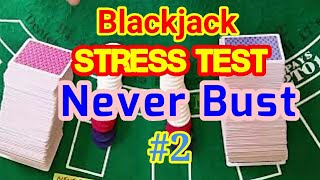Blackjack Strategy Video Source & Information:
Thank you Ken C for catching my miscount at the end of the shoe. Basic strategy should be up 5.5 units (not 10.5).
—–
Six-deck heads-up blackjack comparing “never bust” to basic strategy.
Dealer stands on all 17s. No surrender. Blackjack pays 3:2.
One shoes. ~75% penetration.
The “Never Bust” strategy always stands with a hard 12 or greater.
Each strategy plays off its own shoe, which are exact copies of each other (card values only).
For this series I am not going to show the complete shuffle procedure. As exciting as I know it is for you to watch, it’s far less exciting to watch me set up the second shoe as a copy. I hope I have earned your trust that I am not stacking the deck.
Each player starts with 50 chips.
Flat bet player bets 1 chip per hand.
Table minimum: 1 chip. Table Maximum: 100 chips. This would be the equivalent of a $5/$500 table.
You can also use this (and forthcoming future videos) as a representative scenario to test your betting system or card counting.
I am not a pro dealer, so be nice.
Source: YouTube






![[Brunson FX Winning Strategy] For Baccarat And Win $2,000,000 + Apology To My Haters](https://www.casinovideos.site/wp-content/uploads/2021/07/31422/brunson-fx-winning-strategy-for-baccarat-and-win-2000000-apology-to-my-haters-150x150.jpg)

Never bust is not a fool's deal basic strategy is
Never bust does have a core "let it ride" mechanic. Can't forget that. It tries to take runs into play. How does that change the odds?
Majority of the time i play the never bust strategy but depends on the hands dealt and what the last 4 or 5 cards were before dealers face down card was taken.
Nobody ever play like this. Ever. You are giving the house a huge edge. May as well bet on black or red at roulette.
This strategy gives the house an even bigger edge. It bad.
Usually, basic strategy is not computed over millions of hands (which is called a "simulation"). Rather, it is computed directly assuming equal probabilities for all card ranks ("total-dependent"), or in some cases, computed assuming that only the cards seen between the player and dealer have been removed from the shoe ("composition-dependent"). Assuming you've programmed the rules right, you can calculate total-dependent basic strategy in a fraction of a second. Basic strategy doesn't guarantee that you'll win, but does guarantee that each decision you make is the best, *on average*, given the information you are considering (either your total, or your cards plus the dealer up card).
I agree with what you're saying regarding your critics. It is pointless to criticize the exercise you are performing here. While it is true that we know that basic strategy is better than never-bust, it is still fun, nevertheless, to perform the experiment, and to see how it works in practice. Nowadays, you could program such an experiment, run thousands of hands (a simulation), and verify that the difference in house edge is what is reported at wizardofodds, but probably that wouldn't make for an interesting experiment, or a good YouTube video. And what you're doing here is very similar to what people like Doyle Brunson did in the past for poker. Who is the favorite to win with a pocket pair versus AK? He figured it out by putting out boards and playing it hundreds of times. It's maybe not as efficient as programming, but sometimes doing things by hand, and getting a feel for something, has great value in of itself.
I’ve watched a total of five minutes on the 1st and second video. You have a serious flaw in basic strategy as the couple times I saw you bust you didn’t play out the dealer cards……which would be done no matter the result so the entire tests are flawed
I trust wizard of odds math. If he says never bust gives the house a bigger edge then that is what it is.
Best strategy is to count cards and use basic strategy. Of course, when counting, there's a number of deviations from "normal" basic strategy.
Lol that garbage does not work. If you play no bust blackjack your giving the house a even bigger advantage at around 5 percent which is huge. Blackjack can be beat but not like this